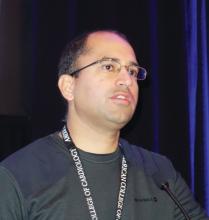SNOWMASS, COLO. – , Ajay J. Kirtane, MD, declared at the Annual Cardiovascular Conference at Snowmass.
“We have to recognize the fact that our success has somewhat plateaued. We’ve made great strides in shortening door-to-balloon times, but further reductions in [that measure] are not translating into further reductions in adverse outcomes,” observed Dr. Kirtane of Columbia University, New York.
That may be in part because the rush to “beat the clock” is at odds with thoughtful evaluation of complex conditions, the cardiologist added.He and others have identified a number of reasons why ST-elevation myocardial infarction (STEMI) mortality has flattened. One is the continued protracted lag time from symptom onset to arrival at the emergency department. Progress here will require effective public education programs.
“By the time patients are getting to the cath lab, we’re sort of running out of time to salvage the myocardium,” Dr. Kirtane said. “We need to get people to the lab really, really quickly and recognize that symptom onset is still an area in need of improvement.”
The greatest limitation of primary percutaneous coronary intervention (PCI) for treatment of STEMI, however, is poor recovery of left ventricular function. As STEMI mortality has fallen over the years, rates of heart failure caused by suboptimal salvage of myocardium have climbed. Only about two-thirds of patients undergoing primary PCI obtain successful reperfusion; that’s in part due to distal embolization, a problem that hasn’t yet been solved.
One hope for improved reperfusion success that has been dashed is aspiration thrombectomy. It was an attractive concept, but optical coherence imaging has shown that after aspiration, there is still a good deal of thrombus remaining in the vessel. And large randomized trials failed to show a reduction in ischemic events. Thus, the current American College of Cardiology/American Heart Association STEMI guidelines give routine aspiration thrombectomy before primary PCI a class III rating, meaning don’t do it (J Am Coll Cardiol. 2013 Jan. doi: 10.1016/j.jacc.2012.11.019).
What about nonculprit lesions?
A hot topic in STEMI management is what to do about residual disease in nonculprit vessels after primary PCI.
“Some people have drawn upon trials like COURAGE to inform their decision making, saying ‘Now the patient is stabilized, we’ve treated the STEMI, so we could now treat the patient like a COURAGE patient [with optimal medical therapy alone].’ I would caution against extrapolating the results of COURAGE and other stable ischemic heart disease paradigms to these types of patients. They’ve already presented with a very high risk feature – STEMI – and in addition, in the COURAGE trial there were only 118 patients that had acute coronary syndrome of less than 2 weeks’ duration out of more than 2,000 subjects,” Dr. Kirtane said.
“Intravascular ultrasound studies show that nonculprit plaques in stable angina are very different from those in STEMI: They’re typically fibrotic and stable, while even the nonculprit plaques in STEMI or non-STEMI ACS are much more inflamed and vulnerable,” he added.
He predicted clarity regarding best management in this area will come from the ongoing COMPLETE trial, a multinational study of nearly 4,000 patients randomized to staged nonculprit lesion PCI versus medical therapy plus culprit lesion-only revascularization. The study is due to be completed late in 2018.
Improving pharmacotherapy
Rates of hospital discharge on guideline-directed optimal medical therapy after primary PCI have risen steadily in recent years. However, studies indicate a significant minority of patients drop from dual-antiplatelet therapy to aspirin alone within a month after leaving the hospital.
Also, it’s essential to effectively inhibit both platelets and thrombus in the catheterization lab. But is that happening consistently? There is now evidence of delayed absorption of the potent oral antiplatelet agents in STEMI patients. Moreover, that delay is exacerbated by having morphine or fentanyl on board.
“It’s been shown that even with ticagrelor and prasugrel, in STEMI patients at 2 hours, you still don’t have sufficient inhibition of platelet aggregation, whereas if I gave one of those drugs to any of us here in the audience now we’d have full effect within an hour or 2 max. That’s one of the reasons why there’s a rationale for using an intravenous agent such as cangrelor [Kengreal], a nonthienopyridine direct P2Y12 inhibitor,” Dr. Kirtane said.
Transradial access for primary PCI
Dr. Kirtane argued in a recent editorial that widespread adoption of transradial PCI for STEMI will provide the next major advance in STEMI systems of care resulting in improved clinical outcomes (JAMA Cardiol. 2017 Oct 1;2[10]:1057-8).
This is a controversial issue, he acknowledged. “There are interventional cardiologists who say, ‘No way.’ ” But studies indicate that transradial PCI for STEMI reduces mortality by 16%-48% compared with transfemoral access, without a significant cost in terms of door-to-balloon time. For now, transfemoral access PCI remains the most common strategy for STEMI patients in the United States, although the use of transradial primary PCI is growing.
Dr. Kirtane reported receiving research grants from more than half a dozen medical device companies.


